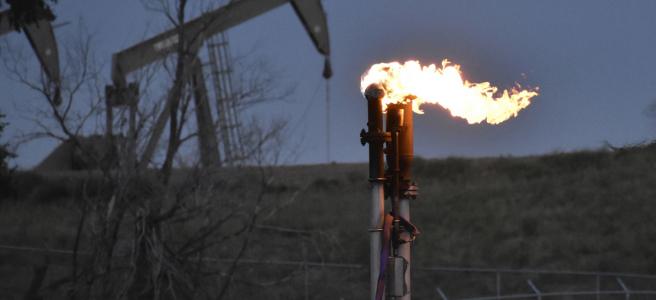
By Mike Lee, Carlos Anchondo
A new “super-emitter” provision in EPA’s proposal to regulate methane emissions would empower third parties to identify large leaks of the greenhouse gas, putting more pressure on oil and gas operators to quickly fix any problems.
EPA released the updated proposal on Friday, coinciding with President Joe Biden’s remarks at the U.N. climate summit in Sharm el-Sheikh, Egypt (Climatewire, Nov. 11). The new proposal, which updates the methane draft rule unveiled at last year’s U.N. talks, includes a program that would require oil and gas operators to respond to large-emission events identified by EPA-approved third parties.
The result would be a wider circle of leak investigators — and potentially a rise in communities partnering with nonprofits and others to investigate nearby oil and gas infrastructure.
“There are a lot of possibilities for this super-emitter program to kind of share the burden and really make sure that when we see a big leak, we can get it stopped as quickly as possible,” said Darin Schroeder, an attorney with the Clean Air Task Force, in an interview. “I think that’s really important for the people that live near those leaks.”
The oil and gas industry is one of the largest sources of methane, which traps roughly 80 times as much heat as carbon dioxide during its first 20 years in the atmosphere. A handful of environmental groups already use optical gas imaging cameras — the same equipment EPA uses — to document sources of methane emissions in oil fields across the country.
But when those groups find a leak, their complaints often go to state regulators, who are then in charge of enforcing local regulations on pollution. Sometimes state agencies take action, and sometimes they don’t.
Under EPA’s draft rule, approved third parties would make such complaints directly to owners and operators, triggering federal requirements. Companies would be required to analyze a leak within five days of being notified, according to an EPA fact sheet. In cases where a leak was caused by a malfunction, the operators would have 10 days to fix the problem. If mitigation would take longer than that, operators would have to develop a corrective action plan and schedule.
The oil and gas industry has complained in the past about third-party findings of leaks, asserting that they sometimes contain errors. Under the EPA proposal, companies could ask the EPA to revoke a third party’s certification, “if they can demonstrate that repeated notifications contained verifiable errors.”
Asked about EPA’s proposed super-emitter response program, the American Petroleum Institute declined to comment. Kathleen Sgamma, president of the Western Energy Alliance, said support would depend on how the program is implemented.
“What’s happened in the past is that conclusions are drawn that a facility is a ‘super emitter’ when in reality what’s detected is a maintenance event with a short-duration release that’s not indicative of continual operations,” Sgamma said Friday in an emailed statement.
Harnessing community power
Andrew Klooster, a field advocate for the environmental group Earthworks, said a recent case in Colorado shows how the EPA would help local communities. Almost two years ago, he pulled up to an aging oilfield outside Fort Collins, Colo., and was hit with a “pretty powerful, knock-you-off-your-feet odor.”
Klooster was there to document what surrounding homeowners already suspected: The tank battery was leaking a mix of methane and other pollutants that were wafting into the surrounding community. Armed with a $100,000 gas imaging camera, he captured the plume of methane and other gases that are invisible to the naked eye.
But it took more than 18 months for before the Colorado Department of Public Health and Environment ordered the tank battery to shut down.
The state has some of the strictest oil and gas regulations in the country, but shutting down the battery only happened after a concerted campaign by local homeowners, Earthworks, the city of Fort Collins and Larimer County. State inspectors eventually discovered that the tanks were not just leaking methane, but also hydrogen sulfide, a potentially deadly gas.
EPA’s proposal aims to both make such reporting more common — and the response much quicker. In releasing the new draft rule, the agency pointed to comments from groups affected by oil and gas pollution, including communities that expressed environmental justice concerns.
The super-emitter response program will “create opportunities for communities to partner with entities engaged in remote sensing to monitor nearby sources of emissions,” the agency said.
While the oil and gas industry hasn’t come out for or against the proposal, some companies have expressed openness to third-party data. In a January 2022 letter to EPA, BP PLC gave qualified support to such data.
“In principle, and to the extent third-party organizations are able to contribute data that are legally collected and scientifically sound, BP believes that harnessing the power of this information can help to identify and solve problems in a transparent, efficient, and responsible way,” the company wrote.
In Egypt, Biden focused on the new proposal’s standards for super-emitters.
Such strong regulatory action to strengthen methane standards, he said, will “make sure it’s not released into communities, impacting our public health.”
This article also appears in Climatewire.
Read more: https://www.eenews.net/articles/how-epas-draft-methane-rule-targets-super-emitters/

